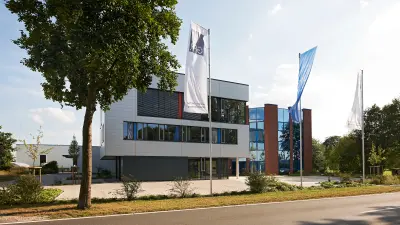“Green buildings would be impossible without automation”
Professor Uwe Rotermund teaches property lifecycle and facility management at the Münster University of Applied Sciences in Germany. Every day he searches for ways to make the most of building automation to simplify living and working conditions.

You have been studying building automation for over 35 years. When you first embarked on this journey, did you anticipate the rapid developments that this field has seen in recent years?
Prof. Rotermund: Yes, we expected things to continue evolving rapidly because IT was already in full swing by that time. But then the enormous technological strides made in developing control equipment and new ways of communicating took us by surprise. The ability to control systems on site or from anywhere in the world and monitor and evaluate data in real time using a tablet computer is simply spectacular ― a revolutionary breakthrough. Now we can say with satisfaction that what we dreamed of back then has now become reality.
Building automation has become part of our everyday lives. What makes this field of research so fascinating and above all relevant?
Prof. Rotermund: The whole business of optimizing how buildings work has enormous future relevance, which makes it an exciting field of study. From my perspective, we need to stop focusing so obsessively on details, like whether making thermal insulation a centimeter thicker will save energy, and look at the bigger picture. This means investigating how to fully tap the potential of automation technologies in a larger context.
We are also intensively studying fundamental issues such as how to design a truly effective operator model. There’s no doubt that building automation is a very important instrument for management. Automation, instrumentation, control and regulation ― once all this has been provided, it’s up to management to leverage all of the possibilities.

Building automation is also highly cost-driven. We therefore constantly monitor and benchmark property utilization costs and operate Germany’s largest cross-industry database on building utilization costs.
Economic aspects naturally play an extremely important role for operators and investors: energy costs, management costs, maintenance costs, automation costs ― a wide array of different costs is involved, with a lot of parameters that can be tweaked.
We therefore crunch a lot of numbers for projects in their early stages, identify feasible targets, and then try to help achieve these during the construction phase. This can be accomplished by actively deploying automation as a tool.

It’s essential to meticulously tailor IT systems to meet future technical requirements.
Talking about potential, what is the main strength of automation going forward?
Prof. Rotermund: Everyone is familiar with Excel or Numbers, for example, so I’d like to draw a comparison with these programs. If we imagine building automation as a kind of huge Excel application that lets you program complex macros and formulas, many people actually only use their “building Excel” like a pocket calculator. They fail to tap its enormous potential and functionality ― yet that should be the goal.
If an available, complex building automation system is only being used as an alarm control center at best, it’s largely being wasted. To improve this situation, both operators and users need to be proactive. Their facility management systems, whether these are run in-house or by external service providers, call for clear instructions and expectations as to how the system is used and which data and reports should be read and converted into appropriate scenarios. In many cases, operators should reject the lowest price and opt for a sustainable, energy-efficient building instead. IT systems for this shouldn’t be chosen during the construction phase, i.e. at the last minute, purely on the basis of price, since it’s essential to meticulously tailor them to meet future technical requirements!
In the final analysis, building automation is part of a company’s overall digitization strategy. It’s necessary to define goals, decide which data should be captured and evaluated, and then select and install appropriate technologies and systems. In a best-case scenario, these are optimally networked and function as integrated solutions. It’s vital to seamlessly merge the digitization strategy, IT systems, and organizational structure ― otherwise building automation will be unable to deliver full benefits. It’s naturally imperative for the client to communicate this strategy to those responsible for planning the system.
Digitization, sustainability, demographic change: what is the relationship between building automation and social and technological megatrends?
Prof. Rotermund: Without digitization, building automation wouldn’t be where it is today. Sustainability is also a central theme in this context: without automation, green building operation wouldn’t be possible. Meaningful, steadily improving benefit-oriented energy management, prevention of pollution, occupancy-sensitive adjustments, on-site management ― building automation makes it possible to ideally harness all of these things in the interests of sustainability. And in tune with current societal trends, it’s clear that automation also increases remote control capabilities, like for working from home or making workplaces and working hours more flexible.

Automation significantly simplifies and improves processes and individual work steps. How do operators and facility management in particular benefit?
Prof. Rotermund: For one thing, the level of comfort inside buildings greatly improves. The market value of extensively automated buildings is also much greater, and they are simply more attractive. In addition, data is the gold of the future, and automation spews out enormous quantities of the stuff. Systematically mined, it generates outstanding opportunities for making improvements. Another plus point is that the approach to maintenance is very different. Ordinarily, a building’s systems are flagged for servicing once a year, whether or not this is actually needed. This changes with automation. We’re all familiar with how it works with cars: when a vehicle needs to be taken in for inspection after a certain number of months or kilometers, a reminder is automatically displayed, prompting us to take action. Automated buildings also let us know if and when they need attention. This significantly lengthens maintenance intervals. Add IoT-capable devices to the mix, and automation generates enormous value in the context of facility management. Thirty-five years ago, we could only dream of technologies like talking coffee machines or smart lighting systems.
Building automation thus provides a host of opportunities. But there is also a risk that I would like to mention: excessively dissecting systems offsets the integration effect. If every manufacturer offers its own proprietary cloud solutions, it’s essential to sensibly link them ― otherwise all the clouds will cause thunderstorms.

Ultimately, building automation plays an essential role in a company’s overall digitization strategy.
Looking ahead, what role will building automation play in the individual phases of property lifecycles?
Prof. Rotermund: A major role. One reason is that buildings are increasingly technologized, and another is that the use of technology can be very finely tuned and differentiated for each application, depending on whether the focus is on user comfort and convenience or the technology itself.
It also has considerable repercussions on the cost of ownership over an asset’s entire useful life. Which replacement cycles have to be taken into account, and how often do facilities need to be renovated and modernized? When designing a complete solution, we strive to maximize cost-effectiveness. It matters that only 20% of a building’s total costs are incurred to build and equip it, while operation and use during the rest of its lifetime account for the lion’s share. So if you plan and implement building automation at an early stage, the subsequent economic benefits are greatly magnified.
During a building’s commissioning phase, automation should be taken advantage of to fine-tune it for the conditions under which it will operate. Building automation is a powerful tool for accomplishing this, but the building’s operators have to work with other involved parties to identify and implement the best possible strategies. This won’t work if, for example, automation systems are purchased at rock-bottom prices in a bidding war or the building’s manager lacks the skills needed to use them. It can only be achieved with “genuine” integral planning of the building while making sure that it meshes with the operational model and concept. In some areas, however, this will require our highly cost-driven industry to considerably change its current way of thinking.
When building operators or investors make plans to integrate automation systems today, what should they focus on?
Prof. Rotermund: First of all, building automation has to be properly used and operated, otherwise there’s no point! The widely held idea of it as a kind of glorified alarm control system is a misconception ― it’s actually an instrument for evaluating and interpreting data. A market survey carried out by fm.benchmarking in 2018 revealed that 80 to 90% of all respondents already had a building automation system. But when these were asked which functions they actually use, the rate dropped to about 40-50% among owner-users and in the case of external service providers all the way down to 10-30%. In my opinion, this is a very critical figure and confirms misconception I just mentioned, namely that these systems are like better pocket calculators.

Their full range of functionality is almost never exploited, and their valuable data history and trend assessment capabilities in particular are still used far too rarely. If you track how systems operate over the course of the day, or investigate whether lighting, air conditioning or heating could be switched off earlier, for example, you can gain major insights and spot opportunities to achieve substantial savings. But to benefit from these, you have to constantly work with and interpret the data.
And what don’t we need to worry about?
Prof. Rotermund: You don’t have to be a rocket scientist to use a building automation system. There’s no need to be shy; you don’t even have to understand the details of the technology inside the switch cabinet. After all, you have competent partners to help you with that. And if I may venture a look at the near future, home automation is already giving us a glimpse of what will soon also be standard in commercially used buildings. Controlling building automation systems will become increasingly transparent and user-friendly, and new communication media like smartwatches will facilitate interactions with users. Improved visualization techniques, greater flexibility for configuring systems to meet different wishes and needs, and customer-appropriate engineering are poised to encourage far greater use of building automation down the road and drive spectacular business success stories.
Working together for green buildings
Find out how our smart solutions and customized services are promoting sustainable buildings, climate neutrality, and environmental awareness.



